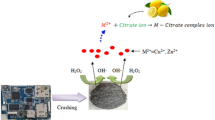Abstract
Global digitisation and availability of affordable and advanced electrical and electronic equipment (EEE) have aggravated the management problem of waste electrical and electronic equipment (WEEE) or electronic waste (e-waste) around the world. According to a report published by Baldé et al. (2017), global electronic waste (e-waste) generation in the year 2016 is estimated to be 44.7 Mt and projected to grow to 52.2 Mt by 2021. EEE has been categorised into two categories: (a) Information technology and telecommunication (IT and telecom) equipment and (b) consumer electrical and electronics (e-waste management rules, 2016). End-of-life mobile phones (Eol-MPs) are contributing a major portion in e-waste content because of its high obsolescence rate and ever-increasing consumer base and year-wise sales as shown in Fig. 1 (Beigl et al., 2012; Kasper et al., 2011; Monteiro et al., 2007; Osibanjo and Nnorom, 2008; Robinson, 2009). Printed circuit board (PCB) is the core component of any EEE so as of end-of-life mobile phone (EoL-MP). Metal recycling from the PCBs of EoL-MP as a secondary resource has become a necessity both from an economical and environmental point of view considering the abundant presence of base, precious and toxic metals in them.
Access this chapter
Tax calculation will be finalised at checkout
Purchases are for personal use only
Similar content being viewed by others
References
Baldé, C.P., Forti, V., Gray, V., Kuehr, R. and Stegmann, P. (2017). The Global E-waste Monitor–2017, United Nations University (UNU), International Telecommunication Union (ITU) & International Solid Waste Association (ISWA), Bonn/Geneva/Vienna. Electronic Version, pp. 978–992.
Behera, S.K., Meena, H., Chakraborty, S. and Meikap, B.C. (2018). Application of response surface methodology (RSM) for optimization of leaching parameters for ash reduction from low-grade coal. Int J Mining Sci Technol, 28(4): 621–629.
Beigl, P., Schneider, F. and Salhofer, S. (2012, February). Takeback systems for mobile phones: Review and recommendations. In: Proceedings of the Institution of Civil Engineers-Waste and Resource Management, 165(1): 25-35. ICE Publishing.
Chauhan, G., Pant, K.K. and Nigam, K.D.P. (2015). Chelation technology: A promising green approach for resource management and waste minimization. Environ Sci: Processes Impacts, 17(1): 12–40.
Deveci, H., Yazici, E., Aydin, U., Yazici, R. and Akcil, A. (2010, November). Extraction of copper from scrap TV boards by sulphuric acid leaching under oxidising conditions. In: Proceedings of the Going Green-CARE INNOVATION 2010 Conference (pp. 8–11).
E-waste (Management) Rules (2016). Ministry of Environment, Forest and climate Change, Government of India http://moef.gov.in/wp-content/uploads/2017/07/EWM-Rules-2016-english-23.03.2016.pdf. Accessed 2 July 2019.
Huang, K., Guo, J. and Xu, Z. (2009). Recycling of waste printed circuit boards: A review of current technologies and treatment status in China. J Hazard Mater, 164(2–3): 399–408.
Jadhao, P., Chauhan, G., Pant, K.K. and Nigam, K.D.P. (2016). Greener approach for the extraction of copper metal from electronic waste. Waste Manage, 57: 102–112.
Kasper, A.C., Berselli, G.B., Freitas, B.D., Tenório, J.A., Bernardes, A.M. and Veit, H.M. (2011). Printed wiring boards for mobile phones: Characterization and recycling of copper. Waste Manage, 31(12): 2536–2545.
Lee, J.C., Song, H.T. and Yoo, J.M. (2007). Present status of the recycling of waste electrical and electronic equipment in Korea. Resources Conserv Recycl, 50(4): 380–397.
Li, J., Lu, H., Guo, J., Xu, Z. and Zhou, Y. (2007). Recycle technology for recovering resources and products from waste printed circuit boards. Environ Sci Technol, 41(6): 1995–2000.
Means, J.L., Kucak, T. and Crerar, D.A. (1980). Relative degradation rates of NTA, EDTA and DTPA and environmental implications. Environ Pollut B, Chem Phys, 1(1): 45–60.
Mishra, D., Kim, D.J., Ahn, J.G. and Rhee, Y.H. (2005). Bioleaching: A microbial process of metal recovery; a review. Met Mater Int, 11(3): 249–256.
Monteiro, M.R., Moreira, D.G., Chinelatto, M.A., Nascente, P.A. and Alcântara, N.G. (2007). Characterization and recycling of polymeric components present in cell phones. J Polym Environ, 15(3): 195–199.
Montgomery, D.C. (2017). Design and Analysis of Experiments. John Wiley & Sons.
Osibanjo, O. and Nnorom, I.C. (2008). Material flows of mobile phones and accessories in Nigeria: Environmental implications and sound end-of-life management options. Environ Impact Assess Rev, 28(2–3): 198–213.
Pastor, J., Aparicio, A.M., Gutierrez-Maroto, A. and Hernández, A.J. (2007). Effects of two chelating agents (EDTA and DTPA) on the autochthonous vegetation of a soil polluted with Cu, Zn and Cd. Sci Total Enviro, 378(1–2): 114–118.
Priya, A. and Hait, S. (2017). Comparative assessment of metallurgical recovery of metals from electronic waste with special emphasis on bioleaching. Environ Sci Pollut Res, 24(8): 6989–7008.
Robinson, B.H. (2009). E-waste: An assessment of global production and environmental impacts. Sci Total Environ, 408(2): 183–191.
Tuwati, A. and Fan, M. (2015). Development of a contaminant leaching model for aquifer storage and recovery technology. Cogent Environ Sci, 1(1): 1066177.
USEPA. (1995). Microwave Assisted Acid Digestion of Siliceous and Organically based Matrices. USEPA Method 3052, 3rd edn. United States Environmental Protection Agency, Washington, DC.
Verma, A. and Hait, S. (2019). Chelating extraction of metals from e-waste using diethylene triamine pentaacetic acid. Process Saf Environ Protect, 121: 1–11.
Yang, H., Liu, J. and Yang, J. (2011). Leaching copper from shredded particles of waste printed circuit boards. J Hazard Mater, 187(1–3): 393–400.
Yi, S., Su, Y., Qi, B., Su, Z. and Wan, Y. (2010). Application of response surface methodology and central composite rotatable design in optimizing the preparation conditions of vinyltriethoxysilane modified silicalite/polydimethylsiloxane hybrid pervaporation membranes. Sep Purif Technol, 71(2): 252–262.
Author information
Authors and Affiliations
Corresponding author
Editor information
Editors and Affiliations
Rights and permissions
Copyright information
© 2021 Capital Publishing Company, New Delhi, India
About this chapter
Cite this chapter
Gupta, N., Trivedi, A., Hait, S. (2021). Column Leaching of Metals from PCB of End-of-Life Mobile Phone Using DTPA Under Oxidising Condition. In: Kalamdhad, A.S. (eds) Integrated Approaches Towards Solid Waste Management . Springer, Cham. https://doi.org/10.1007/978-3-030-70463-6_22
Download citation
DOI: https://doi.org/10.1007/978-3-030-70463-6_22
Published:
Publisher Name: Springer, Cham
Print ISBN: 978-3-030-70462-9
Online ISBN: 978-3-030-70463-6
eBook Packages: Earth and Environmental ScienceEarth and Environmental Science (R0)




